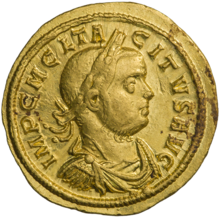Marcus Claudius Tacitus
Marcus Claudius Tacitus (c. 200–July 276) was Roman emperor from 275 to 276 AD.
| Marcus Claudius Tacitus | |||||
|---|---|---|---|---|---|
| Roman emperor | |||||
 | |||||
| Augustus | |||||
| Reign | 275–276 | ||||
| Dies imperii | November/December 275 | ||||
| Predecessor | Aurelian | ||||
| Successor | Florianus | ||||
| Born | Marcus Claudius Tacitus c. 200 | ||||
| Died | July 276
| ||||
| Burial |
| ||||
| |||||
Early life
changeTacitus (Latin: Marcus Claudius Tacitus) was probably born around 200. He may have come from Interamna (Terni, Italy).[1]
Tacitus was a politician from the Roman nobility. He was a member of the Roman Senate. He may have been the leader of the senate (Latin: princeps senatus). Some time before 273, long before he was emperor, Tacitus was Roman consul.[1]
On his way east in September 275 (or possibly in October), the emperor Aurelian was murdered by his own soldiers in Roman Thracia. Aurelian's wife, the augusta Ulpia Severina, may have been in control of the government until Tacitus became emperor.[2]
Emperor
changeThe Greek historian Zonaras wrote that the Roman army chose Tacitus as their emperor. This happened in about November or December 275, while Tacitus was in Campania.[1]
The Historia Augusta (a Latin history) says that the Roman Senate chose Tacitus as their emperor. This is probably not correct.[1]
Tacitus was Roman consul for the second time in 276. Tacitus travelled to Asia Minor that year. In the same year, his armies overcame the Goths in a war. In early summer 276 Tacitus got the name Gothicus maximus because of his success against the Goths.[1]
Death
changeTacitus probably died in July 276. The Historia Augusta says that Tacitus was murdered at Tyana in Cappadocia (Kemerhisar, Turkey). The Historia Augusta also says that Tacitus had a cenotaph at Interamna (Terni, Italy).[1][3] Tacitus was not deified (made into a god) but neither did he get damnatio memoriae.[1]
Family
changeThe Historia Augusta says that Tacitus had a half-brother, Florianus. Tacitus and Florian had the same mother, but different fathers.[1][4] This information may not be correct.[4]
The Historia Augusta says that Tacitus had a wife and a number of sons. Their names are unknown and this information may not be correct.[1]
The Historia Augusta says that the emperor Marcus Claudius Tacitus was from the same family as the Latin historian Cornelius Tacitus. (The historian Tacitus lived in the 1st century AD.) The Historia Augusta is not correct. In truth, the two men were not from the same family. The Historia Augusta also says that the emperor Tacitus's full name in Latin was: Marcus Aurelius Tacitus. This is also not correct. In truth, the emperor's name was Marcus Claudius Tacitus.[1]
References
change- ↑ 1.00 1.01 1.02 1.03 1.04 1.05 1.06 1.07 1.08 1.09 Kienast, Dietmar; Eck, Werner; Heil, Matthäus (2017) [1990]. "Tacitus (Ende 275–Mitte 276)". Römische Kaisertabelle: Grundzüge einer römischen Kaiserchronologie (in German) (6th ed.). Darmstadt: Wissenschaftliche Buchgesellschaft (WBG). pp. 241–242. ISBN 978-3-534-26724-8.
- ↑ Kienast, Dietmar; Eck, Werner; Heil, Matthäus (2017) [1990]. "Aurelian (Sept. 270–Sept./Okt. 275)". Römische Kaisertabelle: Grundzüge einer römischen Kaiserchronologie (in German) (6th ed.). Darmstadt: Wissenschaftliche Buchgesellschaft (WBG). pp. 225–229. ISBN 978-3-534-26724-8.
- ↑ Johnson, Mark Joseph (2009). The Roman Imperial Mausoleum in Late Antiquity. Cambridge: Cambridge University Press. pp. 199–218. ISBN 978-0-521-51371-5. OCLC 309835740.
- ↑ 4.0 4.1 Kienast, Dietmar; Eck, Werner; Heil, Matthäus (2017) [1990]. "Florianus (Mitte–Herbst 276)". Römische Kaisertabelle: Grundzüge einer römischen Kaiserchronologie (in German) (6th ed.). Darmstadt: Wissenschaftliche Buchgesellschaft (WBG). p. 243. ISBN 978-3-534-26724-8.